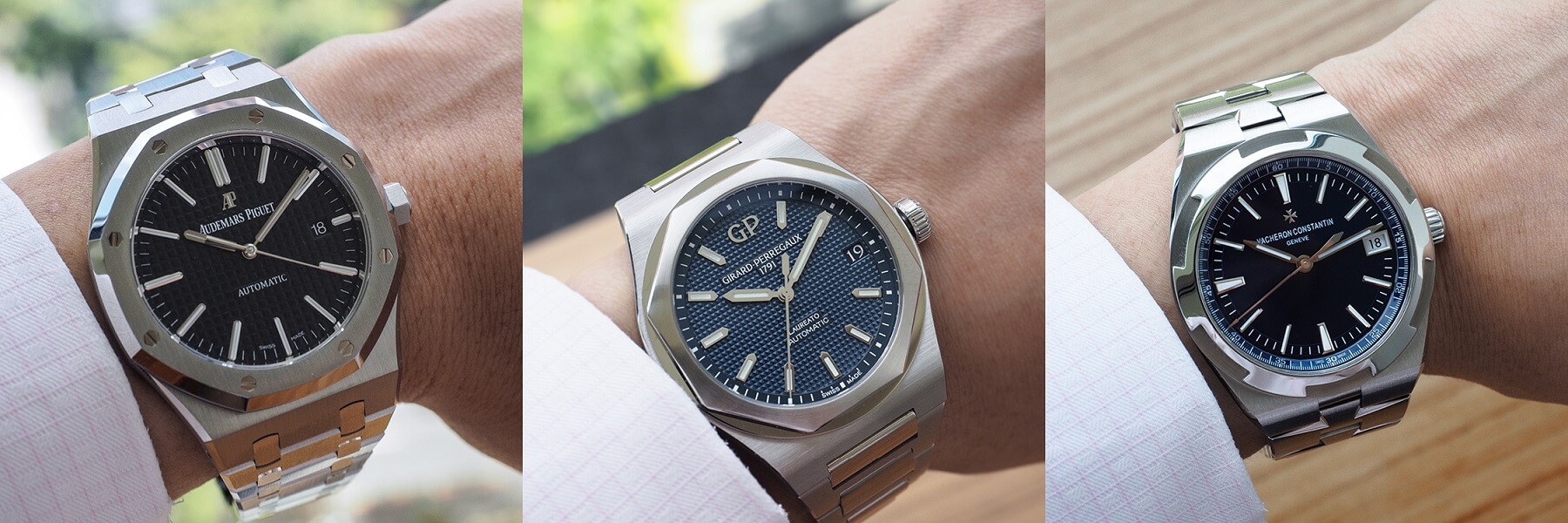New Watch! • 26 May 2017
Watch Roundup: Three Sports Elegance Timepieces
Sports elegance. Sporty chic. Sports luxury. The category may seem nebulous, both in nomenclature and definition, but its members are well defined, beginning with the Audemars Piguet Royal Oak that had started it all in 1972. Perhaps the best way to define (and name) this category is to call it the luxury technical performance sports watch. It’s quite a mouthful, for sure, but encapsulates exactly what the category entails – a timepiece that’s sporty, with a focus on technical performance, yet doesn’t skimp on the luxury factor. Several manufactures offer variations on this theme; it’s a compelling collection to include within one’s product line-up, thanks to its versatility and broad-based appeal. With the relaunch of Girard-Perregaux’s Laureato collection at SIHH this year, we thought it’d be a good idea to take another look at this category, so here’re three watches that we’ve selected.

Lest there’re complaints that some very relevant (and worthy) watches have been excluded, let’s be clear that the coverage here was never meant to be extensive; this category of watches is a rather expansive one, and for a roundup to even be adequate one will also need to include the IWC Ingenieur, Patek Philippe Nautilus (and Aquanaut), and Hublot Big Bang. The three that have been featured here are just the ones with enough similarities for a meaningful comparison, differences in prices notwithstanding.
Audemars Piguet Royal Oak Selfwinding (Ref. 15400)

The Royal Oak is the archetypal luxury technical performance sports watch, and for good reason – it was the first such timepiece (in steel no less), and has a bold design that translates extremely well across sizes, complications, and materials, all of which has contributed to its popularity. The genesis of the Royal Oak is an entire story unto itself, but the Cliffs Notes version is this: Gerald Genta had designed the watch in a single day, following a brief by Audemars Piguet’s then managing director, Georges Golay, one day before 1971’s Basel fair. The rest, as the cliché goes, is history.

Ref. 15400 is sized at 41mm, and comes with a self-winding movement, Calibre 3120, that has a 60-hour power reserve. The watch represents, in many ways, a middle-of-the-road model within the Royal Oak collection; it is a simple, classy piece that feels like a “medium” size within a line-up that runs from 33mm quartz models to 44mm high and grand complications, and serves as a good entry into the Royal Oak family.

Gerald Genta’s design remains largely unchanged here, from the various finishings on the surfaces of the watch to the bracelet, a rather stiff affair with little articulation that makes it hug the wrist well. There’s the Grande Tapisserie guilloche pattern too. This waffle-like pattern is reproduced on each dial blank by using a machine that works akin to a pantograph, which allows for microdetails to be engraved – best appreciated with the help of a loupe, of course.

Vacheron Constantin Overseas (Ref. 4500V/110A-B128)

The Overseas traces its origins to Ref. 222, which Vacheron Constantin released in 1977 to mark its 222nd anniversary. Clearly, various watch designs had influenced each other in this period. As its name suggests, the Overseas is grounded in the concept of travel, and built to be versatile yet tough enough for it. Compared to the preceding Overseas collection, the current one is significantly more refined to emphasize the “luxury” aspect of the watch while toning down its sporty slant.

When the Overseas collection was overhauled in 2016, a staggering number of models and references were released all at once, from the Overseas Small Model sized for women, to the dressier Overseas Ultra-Thin, to the more technical Overseas Chronograph. Others followed later, such as a worldtimer that properly addressed the needs of frequent travellers. The Overseas model here lacks a suffix and, like the Royal Oak Ref. 15400 above, sits in the middle of the collection’s range, arguably as its purest iteration. The fluted bezel and integrated bracelet are common to the collection and serve to anchor the watch visually with their intricate facets. The latter is particularly eye catching since it’s reminiscent of the Maltese Cross motif, a Vacheron Constantin staple. In contrast, the dial is far simpler, and consists of a smooth, deep blue surface with applique indexes, that’s framed by a minute track chapter ring printed on the flange.

Beneath the dial lies Vacheron Constantin’s Calibre 5100, an in-house automatic movement that was introduced together with the Overseas collection. Like the Royal Oak Selfwinding’s calibre, it has a 60-hour power reserve, but does so with a higher 4Hz frequency instead of 3Hz.

Girard-Perregaux Laureato 42mm

The Laureato 42mm is the third timepiece in this line-up, and traces its origins to the 1970s as well – 1975, to be exact. What makes it so exciting is what it represents: the latest milestone for Girard-Perregaux that is currently going through a metamorphosis under CEO Antonio Calce. As a model, the Laureato represents a tangible part of Girard-Perregaux’s history that Calce is ostensibly determined to reclaim, while simultaneously being the last major collection within the brand’s revamped product line up (at least for now). The Laureato’s pricing is also very sane, which makes for a compelling value proposition.
Let’s get this out of the way first: the Laureato’s design can (and does) invite comparisons to the Royal Oak and Nautilus, both Gerald Genta creations. It’s unavoidable, and the superficial similarities are certainly there, what with the integrated lugs and angular bezel. It’s a distinctly Girard-Perreaux creation though; one needs only to trace the Laureato’s evolution over the years from 1975 to see this, but more on this next time.

The Laureato’s identity is defined by several specifics in its design. The most striking one is its two-tiered bezel, consisting of a slightly rounded octagon atop a circle. This architectural design frames the watch’s dial, which is another signature element of the watch, due to its Clous de Paris guilloche pattern (stamped, not engraved).

Visually, the bezel and case design here conveys a more understated tone than the timepieces above, thanks to the lack of visible screws and the preponderance of smooth surfaces and lines. This translates to the integrated bracelet, which uses large H-shaped links that feel significantly lighter and more comfortable than what their dimensions will suggest.
In terms of its movement, the Laureato 42mm is powered by Girard-Perregaux’s in-house movement, Calibre GP01800-0008, which has a decent 54-hour power reserve. At 30mm, the movement is sized appropriately for the watch’s case as well, with a well-placed date window.












